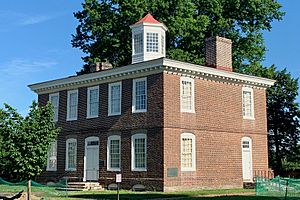William Trent (Trenton) facts for kids
Quick facts for kids
William Trent
|
|
|---|---|
| Speaker of the New Jersey General Assembly | |
| In office 1723 – December 25, 1724 |
|
| Governor | William Burnet |
| Preceded by | John Johnstone |
| Succeeded by | John Johnstone |
| Member of the New Jersey General Assembly from the Burlington County district |
|
| In office 1721 – December 25, 1724 Serving with Thomas Lambert
|
|
| Chief Justice of the New Jersey Supreme Court | |
| In office November 23, 1723 – December 25, 1724 |
|
| Preceded by | David Jamison |
| Succeeded by | Robert Lettis Hooper |
| Personal details | |
| Born | c. 1653 Inverness, Scotland |
| Died | December 25, 1724 Trenton, New Jersey |
| Resting place | Friends' burying-ground, Trenton |
| Spouses | Mary Burdge Mary Coddington |
| Children | James, John, Maurice, Mary, Thomas, William |
| Residences | Philadelphia, Pennsylvania Trenton, New Jersey |
| Occupation | Merchant |
William Trent (born around 1653 – died December 25, 1724) was an important businessman and politician. He lived in Pennsylvania and New Jersey in the late 1600s and early 1700s. The capital city of New Jersey, Trenton, is named after him. We don't know much about his early life, including his exact birth date.
Who Was William Trent?
William Trent was a Scottish merchant who became very successful in the American colonies. He was known for his trading business. He also played a big role in the government of both Pennsylvania and New Jersey.
Early Life and Moving to America
William Trent was born in Inverness, Scotland, around 1653. He moved to the North American colonies in the 1690s. He came with his brother, James.
Trent's Business Career
By 1693, Trent had settled in Philadelphia. He became a very wealthy merchant trader. He was one of the richest people in the city.
He traded in many different goods, including furs and other products. He had business partners and customers in the colonies, the Caribbean, and England. Trent owned parts of more than 40 ships. He exported things like tobacco, flour, and furs. He imported items such as wine, rum, molasses, and dry goods.
Trent's Role in Government
William Trent was also active in politics. In 1704, he was chosen to be part of the Pennsylvania Provincial Council. This council advised the governor, much like a cabinet does today.
He was also appointed to the Supreme Court of Pennsylvania. Later, he was elected to the Pennsylvania Assembly. He even became the Speaker of the Assembly. This meant he was in charge of the meetings.
William Trent's Family Life
William Trent was married twice and had several children.
First Marriage
Trent likely married Mary Burge soon after he arrived in Philadelphia. She passed away in 1708. They had four children together. Their children were James, John, Maurice, and Mary.
Second Marriage
After Mary's death, Trent married Mary Coddington. They had two sons. One son, Thomas, died when he was a baby. Their other son, also named William Trent, grew up and became a successful person too.
Founding of Trenton
In 1719, William Trent built a large country house. It was located in central New Jersey, near the Delaware River. He planned a small town around his house. This settlement became known as Trent's Town. Later, it was officially named Trenton.
Trenton Becomes the Capital
Trenton eventually became the capital city of New Jersey. After moving to New Jersey, Trent became involved in its politics. He was elected to the New Jersey Assembly. He was also appointed as the chief justice of the New Jersey Supreme Court.
The Trent House During the Revolution
During the American Revolutionary War, Trent's house was used by officers from Hesse. These officers were fighting for the British. The house was attacked by Continental Army troops during the Battle of Trenton. After Trenton became the state capital, the Trent House was used as the governor's home for many years.
William Trent's Legacy
William Trent passed away on December 25, 1724. His contributions to trade and government were significant.
The William Trent House Today

The William Trent House is now a very important historical site. It is listed on both state and national registers for historic places. It is also a National Historic Landmark. Today, the house operates as a museum in Trenton. Visitors can learn about William Trent and colonial life there.

